In other articles the first breathing method that I talk about (and often used to teach first) I call easy breathing. I'll call it upright cat/cow breathing here simply because a lot of people are familiar with the cat/cow breathing method. Why not write about that method here?
Because it's done on all fours, and thus, I believe, limited.
The same method can be done while upright with the advantage that you aren't reliant on gravity (or it's less easy to rely on gravity) for the inhale phase. Instead, you can simply focus on bending your spine backwards for the inhales while at the same time feeling your spinal erectors activating as you do this action.
You can relax for the exhale and let gravity pull your ribs down. Alternatively you can pull your belly in as you pull your ribs down and bend your spine forwards for an active exhale.
One of the reasons I like this method, and the reason in other articles I call it easy breathing, is that it is generally easy to pick up. And you can do it anywhere.
Another advantage is that is uses the spinal erectors. Thus you can use it to practice feeling and controlling them. And if you also learn to feel and deliberately expand (and contract) your ribcage, you can then learn to also feel your intercostals, the muscles situated between adjacent ribs as well as the obliques. (You can read about both in obliques and intercostals).
The upright cat/cow breathing method works the spine, helping to maintain spinal mobility. It also works the ribcage and can be used to help maintain ribcage mobility.
A variation of this basic breathing method is to bend just the ribcage (in this case including the thoracic spine) backwards and forwards.
Alternatively you can bend just the lumbar spine and pelvis backwards and forwards.
When doing any sort of breathing exercises, should you breath through your mouth, your nose, or a mixture of both? I'd suggest that as much as possible work at breathing through your nose. For suggestions on how to make working towards that easier, read breathing basics.
Another breathing method is costal breathing. In basic costal breathing, you can work to keep the spine relatively still and simply lift the ribs and expand the ribcage to inhale. Then, again keeping the spine relatively still, contract the ribs to exhale.
With basic costal breathing, the amount of movement of the ribs, particularly while keeping the spine can be very small.
Note that in the article costal breathing I explain how to make costal breathing a lot more effective. One way of doing so is learning to use the levator costarum muscles. These are muscles that are positioned close to the spinal erectors and can be used to lift the backs of the ribs.
You could practice costal breathing while keeping the thoracic spine bent forwards. Then try it again with the thoracic spine bent backwards. You may find that either of these two options is actually a little bit easier than trying costal breathing with the spine neutral.
An advantage of any of these costal breathing variations is that they can be used to improve control and mobility of the ribs relative to the spine. Since the ribcage forms the foundation for the shoulders, you may find that better ribcage control may aid in better shoulder control and possibly stronger arms.
For a much more in-depth look at costal breathing, read the costal breathing article.
Another potential breathing exercise is neck breathing.
One simple reason for practicing this is so that you can be aware of when you are using it.
Another reason is that it can be used in combination with other breathing methods for deeper breathing.
The exercise is to simply pull the ribcage up to inhale. Then release it downwards to exhale.
You may find that your belly sucks in as a result of pulling your ribcage upwards and it may be in part why some people do this almost (or completely) subconsciously. As a way to look slim.
One type of breathing exercise that is generally recommended for relaxation and quite often is mentioned in the context of martial arts is belly breathing.
Why it may be so popular is that it utilizes the respiratory diaphragm to expand the belly during inhales. Hence it is also known as diaphragmatic breathing. The exhales can be driven by gravity or by pulling the belly inwards using the transverse abdominis.
In general, using the diaphragm while breathing tends to cause a natural relaxation response.
The Breathing anatomy for yoga teachers page includes step-by-step instructions for diaphragmatic breathing.
I'd suggest here that if you want to relax, any of these methods (bar neck breathing) can be used to relax, particularly if you focus on feeling and controlling your respiratory muscles and on activating them and relaxing them slowly and smoothly.
For belly breathing one thing to note is that if you lift your chest, that tends to add tension to the abdominal wall making it more difficult to expand your belly. And so one potential fix to make learning belly breathing easier is to sit or stand while slouching so that your belly is relaxed. This can then make it easier to push your belly out while inhaling. You can then relax to exhale or actively pull your belly in to exhale.
As you get used to using your diaphragm, you can then try this breathing method with your chest more lifted. Increase the amount of lift gradually.
As a side note, on occasion you may find it helps to anchor your diaphragm. Read more about that in anchoring your diaphragm..
Note that for the exhale portion of the belly breathing method, if you work at pulling your belly in just to the border of your ribcage you may be using your obliques. However, if you work at pulling your belly past the border of your hip bones and ribcage, then you'll be using your transverse abdominis. And I'd suggest that this would be the better option.
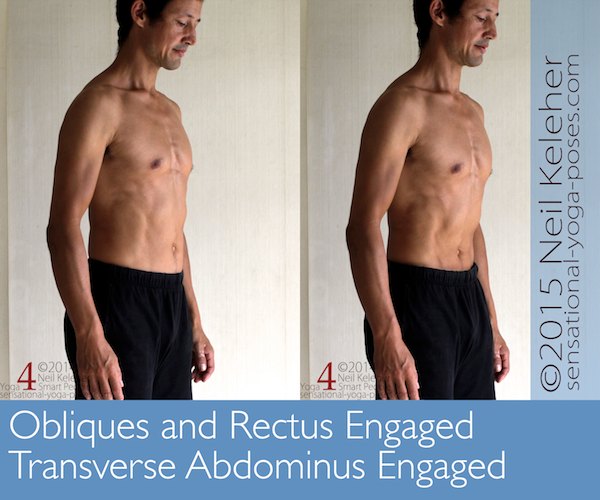
In first picture, obliques are engaged so that abdominal wall is pulled flush with rim of ribcage and pelvis. In second picture, transverse abdominis is engaged so that belly is pulled past the border of the ribcage and pelvis.
Note that muscles in general need a force to work against in order to activate. And so for better control while belly breathing (or using any other breathing technique) you can try using your respiratory muscles in opposition.
While inhaling, resist the outwards push of your belly. Then while exhaling resist the the inwards pull of your belly. In either case the amount of resistance should be minimal. Just enough that you can feel it.
An option for belly breathing is to focus purely on the exhale phase, actively pulling the belly in and then relaxing for the inhale.
For this exercise (and all other breathing exercises) I would suggest that once you have the basic action, work at doing both slowly and smoothly!

Relaxed inhale
(not deliberately expanding the belly)
![Belly breathing with an exhale focus, active exhale When belly breathing with a focus on active exhales, the exhale involves using the transverse abdominis to pull the wall of the belly inwards, past the border of the ribcage and pelvis. Note, this isnt' pulling the ribcage up to [suction] the belly inwards! Neil Keleher, Sensational Yoga Poses.](0-images/transverse-abdominis-activation-1138.jpg)
Active exhale
(not sucking the belly in by lifting the ribcage!)
One reason that I currently like to focus on the exhales is that I've been reading about a tendency for us to over breathe. And I have noticed that when focusing on deep inhales I feel light headed, and not in a good way. I even go as far as practicing holding my breath out (i.e. holding my breath after an exhale.) and working on longer duration holds.
Focusing on the exhale phase of belly breathing can help in training the transverse abdominis and may in some ways be easier than diaphragmatic breathing.
A variation of this belly retraction breathing method is to first pull the belly in so that an exhale is caused. From there, hold the belly in and lift the front ribs and inhale. Then, relax and exhale.
Step one is pulling the belly in. Step two is lifting the ribs. Step three is relaxing both.
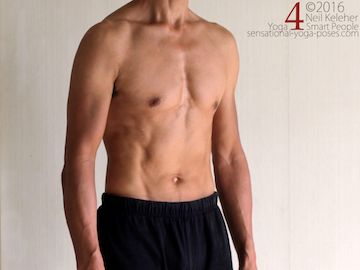
Belly retracted
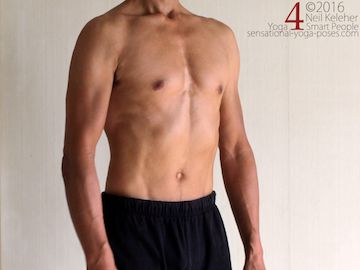
Chest lifted
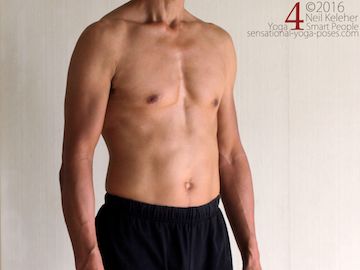
Relaxed
(Chest can sink down!)
One nice thing about this breathing method is that the steps are clearly defined. You may also find that it allows for fairly deep inhales and exhales. One reason that it may be an effective breathing method is that the pulling in of the belly helps to anchor the bottom of the ribcage and diaphragm. Thus the diaphragm (as well as the intercostals) can activate more effectively when you inhale.
A variation of the belly retraction breathing method is to hold the lower belly in. Then breath into the upper belly and ribcage while keeping your lower belly pulled in. As you inhale your upper belly will expand and your front ribs should lift and expand. You can keep the lower belly pulled in as you exhale or turn this into a three part breathing method by relaxing the lower belly after relaxing the upper belly and ribcage.
Yet another breathing method is called reverse breathing. It might better be named as "breathing into your lower back."
In this method the idea is to expand your lower back to cause an inhale.
For the first part of learning the basic actions for reverse breathing ("breathing into your lower back"), you can stand (or sit) with a natural lumbar lordosis. From there, drop your sacrum so that your pelvis tilts back and your lumbar spine flattens.
Then return to the start.
Next, once you are comfortable with the basic movement try to inhale as you drop your sacrum. The feeling you are aiming for is the sensation of breathing into your lower back. Inhaling should cause your lower back to flatten and expand while exhaling should cause your sacrum to lift (tilting your pelvis forwards) and your lumbar spine to bend back.
In diaphragmatic breathing you expand your belly while inhaling. With reverse breathing, you instead expand your lower back as you drop your sacrum (or so as to cause your sacrum to drop.)
You may find that your abs engage when you inhale while doing reverse breathing. The abs activate to help anchor the front of your ribcage and to help expand the lower back and straighten the lumbar spine. While reverse breathing, your diaphragm will contract downwards but instead of your belly expanding outwards, you lower back lengthens vertically
During the inhale phase of reverse breathing, the Quadratus lumborum may be activating. This muscle pulls on your lower ribs (the bottom most pair) from your lumbar vertebrae and from the back of your pelvis. However, instead of activating and shortening, it is activating and resisting the upwards pull of the 12th pair or ribs.
It may actually be lengthening while active.
In either case, its activation (along with the activation of some of the spinal erectors in this region) helps to create the sensation of the lower back expanding or lengthening as if you are "breathing into your lower back".
Note that you may find that the back of your ribs lifts as you do this exercise also.
Muscles can lengthen or shorten or remain the same length when active. The key point with muscle activation is that a muscle needs an opposing force to work against. That opposing force can come from other muscles. The diaphragm and quadratus lumborum both attach to the bottom most pair of ribs (the 12th ribs).
When the diaphragm is active it can exert an upwards pull on this rib while the quadratus lumborum exerts a downwards pull. If both muscles activate, they can work against each other. As a result, the diaphragm can lengthen while the quadratus lumborum shortens or vice versa.
It's like a tug o' war with the two muscles working with each other versus competitively against each other. This tug o' war is what generates sensation.
Yet another breathing method is breathing into the backs of the ribs.
For this method the inhale occurs as you bend your ribcage forwards while at the same time causing the backs of your ribs to lift and the spaces between them to expand.
Instead of lifting and expanding your front ribs (your chest) while bending your thoracic spine backwards, lift and expand your back ribs while bending your thoracic spine forwards. You may find that you actually get a deeper inhale breathing into the back of your ribcage versus the front.
For more on improving ribcage control, so that it's easier to breathe into your back ribs and to feel and control your ribcage in general, the Basic ribcage mobility and control course provides a set of simple video exercises designed to help you feel and control your ribcage.
It's $42.00.
Use this link to find out more:
Basic ribcage mobility and control .
Published: 2021 02 03
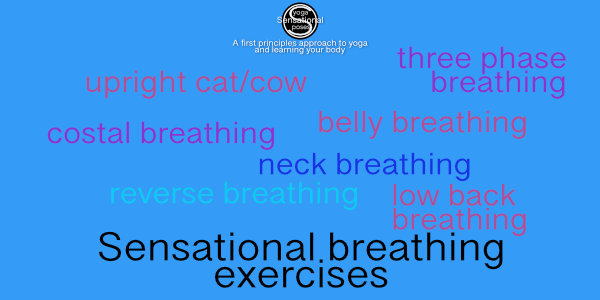
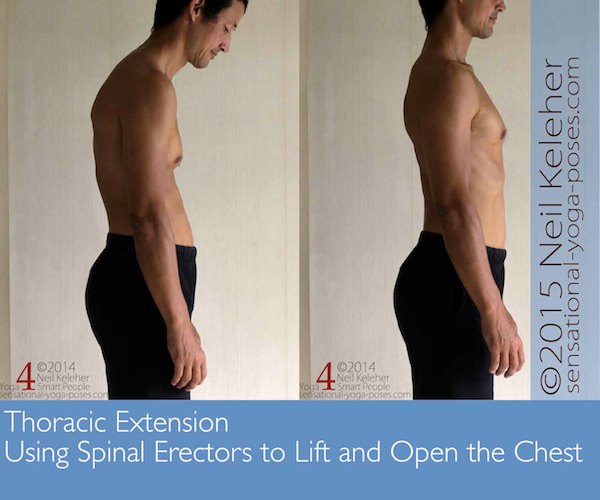
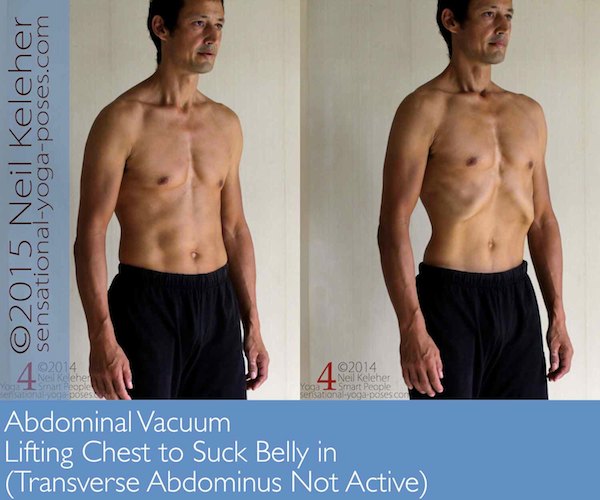
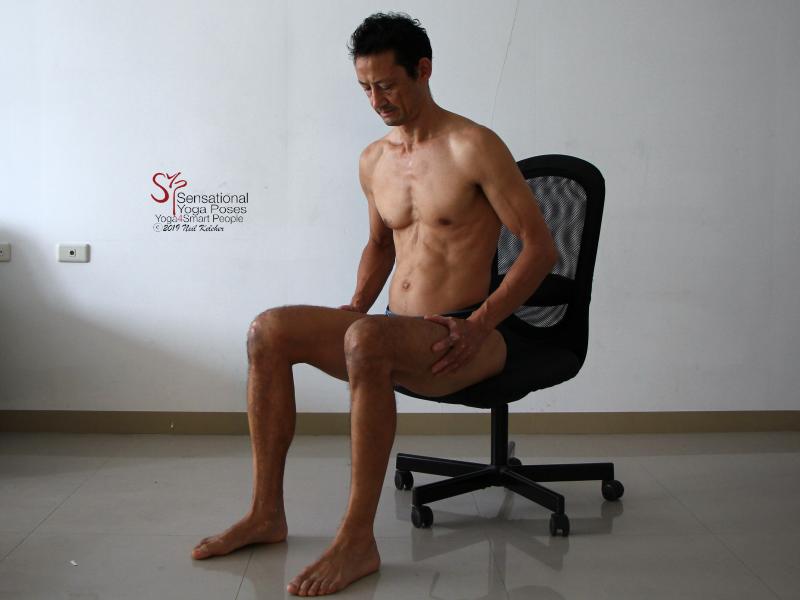
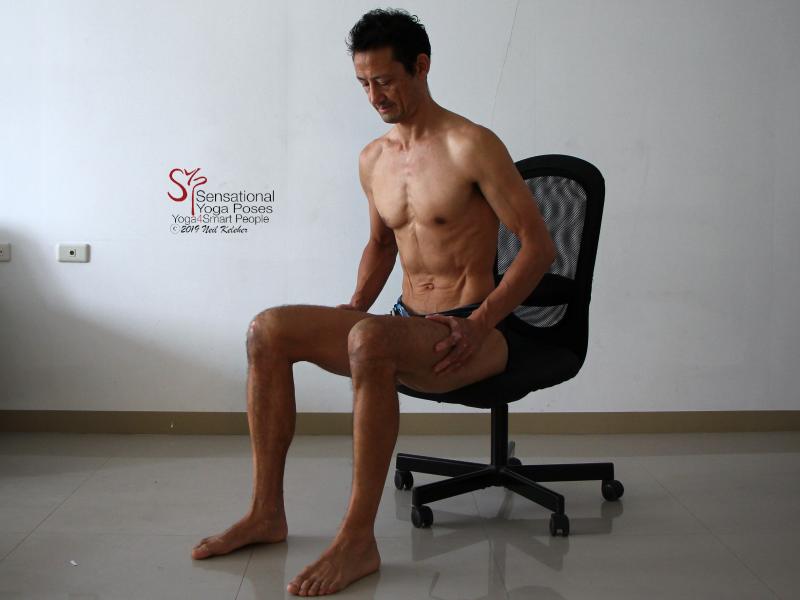


![Belly breathing with an exhale focus, active exhale When belly breathing with a focus on active exhales, the exhale involves using the transverse abdominis to pull the wall of the belly inwards, past the border of the ribcage and pelvis. Note, this isnt' pulling the ribcage up to [suction] the belly inwards! Neil Keleher, Sensational Yoga Poses.](0-images/transverse-abdominis-activation-1138.jpg)





